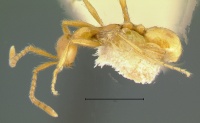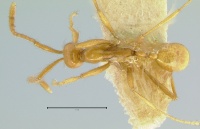Aenictus camposi
| Aenictus camposi | |
|---|---|

| |
| Scientific classification | |
| Kingdom: | Animalia |
| Phylum: | Arthropoda |
| Class: | Insecta |
| Order: | Hymenoptera |
| Family: | Formicidae |
| Subfamily: | Dorylinae |
| Genus: | Aenictus |
| Species: | A. camposi |
| Binomial name | |
| Aenictus camposi Wheeler, W.M. & Chapman, 1925 | |
This species is found from lowland to highland and in natural and disturbed forests. Rosciszewski and Maschwitz (1994) reported that A.camposi fed on other small ant species such as five species of Paratrechina and Prenolepis naoroji in Pasoh Forest Reserve. Malay Peninsula. (Jaitrong et al. 2010)
The type series was collected from a bivouac beneath the bark of a fallen tree.
Identification
Jaitrong et al. (2010) - A member of the wroughtonii group. Aenictus camposi is most similar to Aenictus biroi (see under A. biroi) and Aenictus vieti. It is easily distinguished from A. vieti as follows: the declivity of propodeum is broader with more rounded apex in A. vieti (narrower and distinctly tapering above in A. camposi); subpetiolar process with anteroventral corner acutely angulate in A. vieti (unarmed in A. camposi).
Keys including this Species
Distribution
Aenictus camposi ranges from the Philippines through Sundaland to southern part of continental Southeast Asia.
Latitudinal Distribution Pattern
Latitudinal Range: 9.3023° to 4.333333333°.
| North Temperate |
North Subtropical |
Tropical | South Subtropical |
South Temperate |
- Source: AntMaps
Distribution based on Regional Taxon Lists
Indo-Australian Region: Borneo, Indonesia, Malaysia, Philippines (type locality), Singapore.
Oriental Region: Thailand.
Palaearctic Region: China.
Distribution based on AntMaps
Distribution based on AntWeb specimens
Check data from AntWeb
Countries Occupied
| Number of countries occupied by this species based on AntWiki Regional Taxon Lists. In general, fewer countries occupied indicates a narrower range, while more countries indicates a more widespread species. |

|
Estimated Abundance
| Relative abundance based on number of AntMaps records per species (this species within the purple bar). Fewer records (to the left) indicates a less abundant/encountered species while more records (to the right) indicates more abundant/encountered species. |

|
Biology
Wheeler and Chapman (1930) report a number of workers were taken at Dumaguete from a small colony that was foraging in the open on the ground.
|
Castes
Male

| |
| . | |
Nomenclature
The following information is derived from Barry Bolton's Online Catalogue of the Ants of the World.
- camposi. Aenictus camposi Wheeler, W.M. & Chapman, 1925: 48, pl. 1, figs. 3, 4 (w.) PHILIPPINES (Negros).
- Type-material: lectotype worker (by designation of Jaitrong, et al. 2010: 38), 5 paralectotype workers.
- Type-locality: lectotype Philippines: Negros, Negros Oriental Prov., Horns of Negros, Dumaguete, 1200 m. v. 1918 (J.W. Chapman); paralectotypes with same data.
- Type-depository: MCZC.
- Status as species: Wheeler, W.M. 1930g: 208 (in key); Chapman & Capco, 1951: 11; Chapman, 1963: 262; Wilson, 1964a: 452; Baltazar, 1966: 231; Bolton, 1995b: 59; Wu, J. & Wang, 1995: 51; Zhou & Chen, 1999: 63 (in key); Zhou, 2001b: 62; Jaitrong & Nabhitabhata, 2005: 11; Wang, W. 2006: 637 (in key); Jaitrong, et al. 2010: 38 (redescription); Pfeiffer, et al. 2011: 32; Guénard & Dunn, 2012: 22; Jaitrong & Ruangsittichai, 2018: 113 (in key); Khachonpisitsak, et al. 2020: 25; Wang, W.Y., Soh, et al. 2022: 30.
- Distribution: Brunei, Indonesia (Sumatra), Malaysia (Sabah, Sarawak), Philippines (Luzon, Negros), Singapore, Thailand.
Unless otherwise noted the text for the remainder of this section is reported from the publication that includes the original description.
Description
Worker
Wilson (1964) - Syntype: HW 0.43 mm, HL 0.58 mm, SL 0.59 mm. Antenna 10-segmented. Mandible typical in form. Clypeus feebly convex, entire, dentate. Parafrontal ridge distinct but only 0.1 mm long. Propodeal junction acutely angulate. Subpetiolar process a low, right-angular lobe projecting anteriorly. Pilosity overall sparse, longest pronotal hairs only about 0.10 mm long.
Head smooth and shining. Mesosoma smooth and shining except for mesopleuron and propodeum, which are microreticulate and feebly shining. Also, there are short longitudinal rugae distributed along the propodeal junction. Concolorous clear yellow.
Jaitrong et al. (2010) - (10 non-type workers): TL 2.6-2.7 mm; HL 0.55-0.58 mm; HW 0.43-0.45 mm; SL 0.55-0.58 mm; ML 0.85-0.88 mm; MTL 0.55-0.58 mm; PL 0.25-0.28 mm; CI 74-82: SI 122-135.
Head in full-face view clearly longer than broad, with its sides and posterior margin slightly convex. Antennal scape long, extending beyond posterior corner of head; antennal segment II slightly shorter than III, but longer than each of IV-VI; the last (X) almost as long as VIII and IX combined and as long as II and III combined. Frontal carina short, thin and not extending beyond the level of posterior margin of torulus. Clypeus short, with its anterior margin bearing 5-7 denticles. Mandible with the apical tooth large and curved followed by 10-12 minute teeth on masticatory margin. Mesosoma in profile with pronotum convex dorsally and sloping gradually to metanotal groove. Propodeum in profile lower than promesonotum, with nearly straight dorsal outline; propodeal junction angulate; declivity of propodeum seen from back distinctly tapering above shallowly concave and encircled with a thin rim. Petiole in profile slightly longer than high, with the dorsal outline rather flat, seen from above relatively narrow, almost parallel-sided: subpetiolar process present with its ventral outline convex, without angle or tooth: postpetiole slightly smaller than petiole: its node short, almost as long as broad, in profile elevated posteriorly.
Head, antennal scape, pronotum, petiole, postpetiole, gaster, femora and tibiae of legs entirely or extensively smooth and shiny. Antennal flagellum densely punctate. The anteriormost portion of pronotum punctate: mesothorax and propodeum with dense punctures; metapleuron partly or extensively smooth: propodeal dorsum with short longitudinal rugae along the angle.
Body with relatively sparse standing hairs mixed with sparse short hairs over the surface; length of the longest pronotal hair 0.10-0.13 mm. Head, waist, gaster, antenna and legs yellow, mesosoma pale brown.
Type Material
Jaitrong et al. (2010) - Six syntypes on three pins (one on a pin, two on another, three on the other) from Horns of Negros, 1,200 m alt., Dumaguete, Oriental Negros Province, Philippines (Museum of Comparative Zoology, examined). The single specimen mounted on one pin is selected as the lectotype, the others as paralectotypes.
Determination Clarifications
Jaitrong et al. (2010) - Zhou (2001) recorded this species from Guangxi and some other provinces in China. However, according to his figs. 82 and 83 it is most probably Aenictus vieti.
References
- Borowiec, M.L. 2019. Convergent evolution of the army ant syndrome and congruence in big-data phylogenetics. Systematic Biology 68, 642–656 (doi:10.1093/sysbio/syy088).
- Chapman, J. W.; Capco, S. R. 1951. Check list of the ants (Hymenoptera: Formicidae) of Asia. Monogr. Inst. Sci. Technol. Manila 1: 1-327 (page 11, checklist)
- Khachonpisitsak, S., Yamane, S., Sriwichai, P., Jaitrong, W. 2020. An updated checklist of the ants of Thailand (Hymenoptera, Formicidae). ZooKeys 998, 1–182 (doi:10.3897/zookeys.998.54902).
- Jaitrong, W., Yamane, S. & Wiwatwitaya, D. 2010. The Army Ant Aenictus wroughtonii and related species in the Oriental region, with descriptions of two new species. Japanese Journal of Systematic Entomology 16: 33-36. PDF
- Jaitrong, W. & Yamane, S. 2011. Synopsis of Aenictus species groups and revision of the A. currax and A. laeviceps groups in the eastern Oriental, Indo-Australian, and Australasian regions (Hymenoptera: Formicidae: Aenictinae). Zootaxa, 3128, 1–46. PDF
- Wang, W.Y., Soh, E.J.Y., Yong, G.W.J., Wong, M.K.L., Benoit Guénard, Economo, E.P., Yamane, S. 2022. Remarkable diversity in a little red dot: a comprehensive checklist of known ant species in Singapore (Hymenoptera: Formicidae) with notes on ecology and taxonomy. Asian Myrmecology 15: e015006 (doi:10.20362/am.015006).
- Wheeler, W. M. (1930) Philippine ants of the genus Aenictus with descriptions of the females of two species. Journal of the New York Entomological Society, 38, 193–212.
- Wheeler, W. M.; Chapman, J. W. 1925. The ants of the Philippine Islands. Part I, Dorylinae and Ponerinae. Philipp. J. Sci. 28: 47-73 (page 48, pl. 1, figs. 3, 4 worker described)
- Wilson, E. O. 1964a. The true army ants of the Indo-Australian area (Hymenoptera: Formicidae: Dorylinae). Pac. Insects 6: 427-483 (page 452, see also)
- Yamane, S., Tanaka, H.O., Hasimoto, Y., Ohashi, M., Meleng, P., Itioka, T. 2021. A list of ants from Lambir Hills National Park and its vicinity, with their biological information: Part II. Subfamilies Leptanillinae, Proceratiinae, Amblyoponinae, Ponerinae, Dorylinae, Dolichoderinae, Ectatomminae and Formicinae. Contributions from the Biological Laboratory, Kyoto University 31, 87–157.
References based on Global Ant Biodiversity Informatics
- Borowiec M. L. 2016. Generic revision of the ant subfamily Dorylinae (Hymenoptera, Formicidae). ZooKeys 608: 1–280.
- Chapman J. W. 1965. Studies on the ecology of the army ants of the Philippines genus Aenictus Schuckard (Hymenoptera: Formicidae). Philippine Journal of Science. 93: 551-595.
- Chapman J. W. 1963. Some new and interesting Philippine ants (Hymenoptera: Formicidae). Philipp. J. Sci. 92: 247-263.
- Chapman, J.W. and S.R. Capco. 1951. Check list of the ants (Hymenoptera: Formicidae) of Asia. Monographs of the Institute of Science and Technology (Manila) 1: 1- 327
- Eguchi K., and S. Yamane. 2003. Species diversity of ants (Hymenoptera, Formicidae) in a lowland rainforest, northwestern Borneo. New Entomol. 52(1,2): 49-59.
- Guénard B., and R. R. Dunn. 2012. A checklist of the ants of China. Zootaxa 3558: 1-77.
- Hashimoto Y., Y. Morimoto, and M. Mohamed. 2003. Species List of Ground and Leaf Litter Ants Collected in Lower Kinabatangan. Pp 13-18. In Lower Kinabatangan Scientific Expedition 2002, 176 pp. ISBN-13: 983-2369-11-8
- Herwina H., and K. Nakamura. 2007. Ant species diversity study using pitfall traps in a small yard in Bogor Botanic garden, West Java, Indonesia. Treubia 35: 99-116.
- Hua Li-zhong. 2006. List of Chinese insects Vol. IV. Pages 262-273. Sun Yat-sen university Press, Guangzhou. 539 pages.
- Huang J. 2005. The Fauna and taxonomy of the Formicidae (Insecta: Hymenoptera) from Hunan Province, P. R. China. PhD Thesis, Southwest Agricultural University China Chongqing, 247 pp.
- Jaitrong W. 2015. A revision of the Thai species of the ant genus Aenictus Shuckard, 1840 (Hymenoptera: Formicidae: Dorylinae). The Thailand Natural History Museum Journal 9(1): 1-94.
- Jaitrong W.; Nabhitabhata, J. 2005. A list of known ant species of Thailand. The Thailand Natural History Museum Journal 1(1): 9-54.
- Jaitrong W.; Yamane, S.; Wiwatwitaya, D. 2010. The army ant Aenictus wroughtonii (Hymenoptera, Formicidae, Aenictinae) and related species in the Oriental region, with descriptions of two new species. Japanese Journal of Systematic Entomology 16:33-46.
- Li Z.h. 2006. List of Chinese Insects. Volume 4. Sun Yat-sen University Press
- Matsumoto T., T. Itioka, S. Yamane, and K. Momose. 2009. Traditional land use associated with swidden agriculture chnages encounter rates of the top predator, the army ant, in Southern Asian tropical rain forests. Biodivers. Conserv. 18: 3139-3151.
- Ogata K. 2005. Asian ant inventory and international networks. Report on Insect inventory Project in Tropic Asia TAIIV: 145-170.
- Pfeiffer M.; Mezger, D.; Hosoishi, S.; Bakhtiar, E. Y.; Kohout, R. J. 2011. The Formicidae of Borneo (Insecta: Hymenoptera): a preliminary species list. Asian Myrmecology 4:9-58
- Wheeler W. M. 1930. Philippine ants of the genus Aenictus with descriptions of the females of two species. Journal of the New York Entomological Society 38: 193-212.
- Wilson E. O. 1964. The true army ants of the Indo-Australian area (Hymenoptera: Formicidae: Dorylinae). Pacific Insects 6: 427-483.
- Yamane S.; Nona, A. R. 1994. Ants from Lambir Hills National Park, Sarawak. Pp. 222-226 in: Inoue, T.; Hamid, A. A. (eds.) 1994. Plant reproductive systems and animal seasonal dynamics. Long-term study of dipterocarp forests in Sarawak. Kyoto: Center for Ecological Research, Kyoto University, vii + 255 pp.
- Zhang R. J., L. W. Liang, and S. Y. Zhou. 2014. An analysis on the ant fauna of Nonggang Nature Reserve in Guangxi, China. Journal of Guangxi Normal university: Natural Science Edition 32(3): 86-93.
- Zhou S.-Y. and Chen Z. 1999. The ant genus Aenictus Shuckard from Guangxi (Hymenoptera: Formicidae). Guangxi Sciences 6(1): 63-64.


